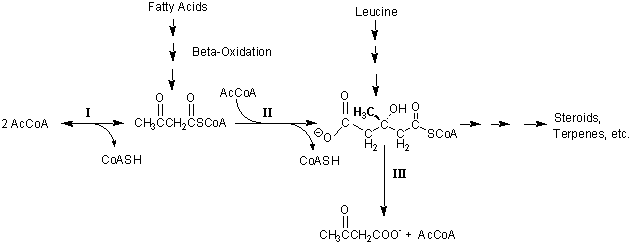

1. Citrate cleavage enzyme (ATP: citrate lyase) is very strongly inhibited by (-) hydroxycitrate [(2S, 3S)-2,3 dihydroxy-3-carboxyl-glutarate] (Arch. Biochem. Biophys. (1969) 135, 209-217). Both fatty acid synthesis and steroid biosynthesis are inhibited by (-) hydroxycitrate (Arch. Biochem. Biophys. (1972) 150, 183-190). What does this imply about the intracellular location and precursors of steroid synthesis. Consider Question 3 of Problem Set No. 2. Would it look the same if incorporation of 3H and 14C into steroids were being measured? Explain.
2. Ketogenesis (reactions I, II & III) is not likely to be inhibited by (-) hydroxycitrate. Taken with the fact that there are isoenzymes for reactions 1 and II, (J. Biol.Chem. (1973) 248, 2275-2284) where in the cell does ketogenesis take place? How many intracellular pools of HMG CoA are there in a liver cell?
3. Using the chemical structures of the substrates and products, compare the reactions catalzyed by HMG CoA synthase (II), HMG CoA lyase (III); citrate synthase (TCA cycle enzyme), and citrate cleavage enzyme in terms of their similarities. Can you predict where the equilibrium of each reaction would lie based on the differences in the reactions. (Remember that equilibrium is a thermodynamic state and has nothing to do with mechanism.)
4. Two specimens of stereospecifically tritiated HMG CoA (A & B) were synthesized (Eur. J. Biochem. (1975) 53, 255-264). Their structures are given below.
These compounds were used to determine the stereochemistry of the HMG CoA lyase reaction. The reaction of HMG CoA to AcCoA and acetoacetate was carried out in deuterated water (D2O). The AcCoA with a chiral methyl group was converted in two enzymatic reactions (shown below) to fumarate and the amount of tritium retained was measured.
From HMG CoA sample A, 73% of the tritium was lost while only 23% of the tritium was lost from sample B. Based on these data, reconstruct the predominant stereochemistry of the AcCoA and malate derived from A & B. Does the HMG CoA reaction mechanism proceed with retention or inversion of configuration?
NOTES - Protium (1H)
is preferentially but not exclusively lost in the malate synthase reaction.
The condensation of AcCoA with glyoxyllate proceeds with inversion of configuration
(Acct. Chem. Res. (1975) 8, 1-10). The fumarase reaction proceeds
by a trans elimination of water (J.A.C.S. (1959) 81, 6333 &
(1961) 83, 3634).